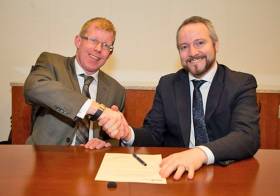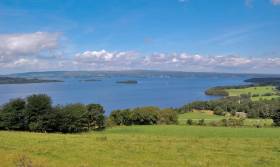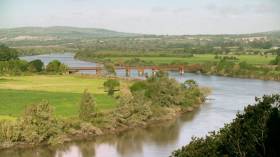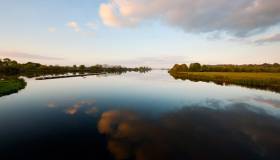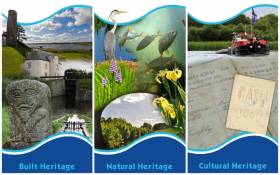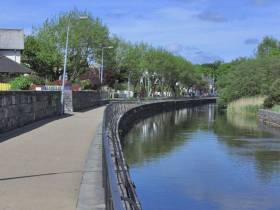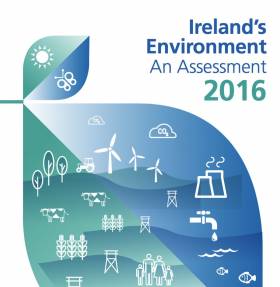Displaying items by tag: inland waters
Inland Fisheries Ireland Signs Up To Save Energy With SEAI
#IFI - Inland Fisheries Ireland has officially signed up to the Sustainable Energy Authority of Ireland’s (SEAI) Partnership Programme, which helps integrate energy management into public sector organisations.
This new partnership will see IFI follow a clear path to achieving targeted energy savings of 33% across the public sector, with a view to achieving year-on-year savings of greater than 3% on top of the 21% increase in efficiency already reached sector-wide.
The State fisheries body says it has already commenced a number of energy saving initiatives in recent years, which include the introduction of ‘green patrols’ for fisheries officers using kayaks and bicycles to patrol angling areas on inland waterways; installing solar panels and insulation on buildings; fuel monitoring and fleet audits; altering lighting; and trialling an electric vehicle.
IFI chief executive Dr Ciaran Byrne commented: “As custodians of the fisheries resource, Inland Fisheries Ireland recognises the importance of energy management as a highly cost-effective means of reducing greenhouse gas emissions and helping to reverse climate change.
“Today [Tuesday 7 March] we have formally committed to reducing our energy usage and our carbon emissions and we look forward to working with the SEAI on reaching our goal by 2020.
“There are many benefits to energy efficiency and aside from environmental reasons; we are also motivated by the desire to operate in a lean manner. We know that many organisations can achieve 20% monetary savings in energy use through proven management and technology solutions so as an organisation, we will benefit year on year.”
Jim Gannon, CEO of the SEAI, added that the agency “is working closely with the public sector to help them to achieve energy savings and agencies such as IFI have a key role to play.
“Already, public bodies have achieved more than €600 million in energy efficiency savings in the last few years with SEAI’s assistance. With more partnerships like the one Inland Fisheries Ireland has committed to today, even more public sector savings can be achieved as we move towards a low carbon future.”
Midlands Waterways To Get ‘Slow Tourism’ Push In 2017
#Tourism - Boating in the Midlands’ waterways will be the focus of a major tourism push this year, as The Irish Times reports.
Fáilte Ireland’s new ‘slow tourism’ initiative will concentrate on promoting existing walking and cycling greenways and ‘blueway’ cruising routes in Midlands counties south from Lough Allen on the upper Shannon.
Minister of State for Tourism Patrick O’Donovan announced the new marketing plans in his address to the Irish Hotels Federation conference in Kilkenny yesterday (Tuesday 28 February).
“We have had the Wild Atlantic Way, Ireland’s Ancient East, and now we are working on a development plan for the Lakelands,” he said.
The Irish Times has more on the story HERE.
Carlow Tourism Industry Members Support Barrow Towpath Plans
#InlandWaters - Carlow Tourism board members were strong in their praise and support for the Barrow Towpath Development Project at their most recent meeting.
Industry members noted that the project, spearheaded by Waterways Ireland, is a “once-in-a-lifetime opportunity” to develop a high quality multi-activity leisure trail, with the ability to give the River Barrow and Barrow Way route an elevated status among Ireland’s inland waterways.
Mark O'Brien, board director and owner of the Old Grain Store Cottages and the Mullicháin Café in St Mullins, said: “For many years and in many reports the River Barrow and the unique features of the towpath which runs alongside it, has been identified as a key tourism asset, but also as a completely under-utilised resource in this regard.
“The key to unlocking the tourism potential of Co Carlow is in no small way rooted in the further development of the River Barrow and Barrow Way route. As has happened along the Great Western Greenway, this project will be the important influencing factor for visitors in their decision to travel to Co Carlow.”
Eileen O'Rourke, chief executive of Carlow Tourism, added that the project “will inject much needed jobs and revenue into Carlow's rural communities, sustaining them to keep local people in their local area.
“Research undertaken by Fáilte Ireland and Mayo County Council in respect of the Great Western Greenway in Mayo, whose length is much shorter than the Barrow Towpath, highlights its noticeable impact on business to the area, contributing €7.2 million annually to the local economy, creating 38 new full-time jobs and sustaining another 56 jobs.”
Board members also noted that “misinformation” is being circulated about the project, such as suggestions that the route would comprise a three-metre-wide tarmac path fenced in from the waterway.
The proposed development will use clean stone and compacted quarry dust to a maximum width of 2.5 metres, similar to that already in use along some stretches of the towpath in Graiguenamanagh, Goresbridge, Leighlinbridge and Bestfield, and in keeping with the standards laid down by the National Trails Office and Transport Infrastructure Ireland (TII) for walking and cycling usage – and will not be of interest to speed cyclists.
Only the existing access roadway downstream from St Mullins Lock, already prone to erosion, will be resurfaced with reinforced concrete, says Carlow Tourism, which promises that the “unspoilt nature of the towpath will be maintained, but with better facilities for the visitor to enjoy.”
Industry members on the board of Carlow Tourism reportedly view the project as responding to a strong market demand by domestic and overseas visitors alike.
James Kehoe — owner of the Lord Bagenal Hotel, whose property fronts onto the River Barrow — notes the increasing emphasis on activity based holidays.
"Currently Co Carlow is not benefiting from this trend, which would be facilitated by completion of the towpath development project. The planning upgrades proposed will increase the year round accessibility of the Barrow towpath to people of all ages and physical ability for a range of activities.
“[At present] visitors are unable to use the towpath at certain periods of the year due to its poor state. It is also very difficult to gauge with reasonably accuracy the state of the towpath in other areas following periods of poor weather.
“The proposed surface will allow us to attract visitors to walk the Barrow towpath, in greater numbers, which will also give greater security to those walking the towpath as single users. I am in no doubt that a range of facilities will accompany the development of this project, which will foster new jobs for the local area."
The proposal has received a warm welcome from Arthur Keppel, president of the Inland Waterways Association of Ireland’s Barrow branch and chair of the Barrow Awards judging panel.
"The Barrow Awards are designed to reward towns and villages along the River Barrow for maintaining and enhancing the wonderful natural resources of the river,” he said. “Year on year we see excellent projects implemented by groups, in an entirely voluntary capacity who are keen to ensure an enjoyable experience for users of the towpath in their respective areas.”
Industry members of the board were strong in their praise for Waterways Ireland and their level of engagement and consultation with the public.
They also noted that the proposal forms part of a larger strategy for the River Barrow, completed by Waterways Ireland in consultation with a number of key partners, with the goal of ensuring higher visibility and recognition for Ireland's second longest river as a special area with strong heritage values.
The strategy recognises the potential of the river to become a busier waterway, as in years gone by when the river was a commercial hub, with benefits for both locals and visitors.
IFI Recruiting Fisheries Officers For 2017 Season
#Jobs - Inland Fisheries Ireland (IFI) is currently seeking to recruit a number of staff as fishery officers nationally for periods of up to six months during 2017.
Fisheries officers will be primarily concerned with the implementation and enforcement of the provision of the Fisheries Acts, Water Pollution Acts and other relevant statutory provisions. They are required to:
- Provide, in co-operation with other fisheries staff, comprehensive conservation and protection services, inland and at sea, within any part of a fisheries district and/or any other area assigned within one or more fisheries districts.
- Provide, in co-operation with other fisheries staff, comprehensive improvement, and development and fisheries management support services within any part of a fisheries district and/or any other area assigned within one or more fisheries districts.
A number of positions will be concerned with assisting either directly or indirectly in fisheries related research projects. The full job specification is available HERE. Please note a full driving licence valid in the State is required.
Applications (a cover letter and up-to-date CV) should be emailed to [email protected] by 5pm on Monday 27 February quoting ‘HR/FO/2017’. Late applications will not be processed. All enquiries to [email protected]
Salary will be at the first point of the Fishery Officer Scale (as of 1 January 2016) plus an unsocial hours allowance, which will be paid at either 50% or 100% relative to the number of unsocial hours worked.
IFI is an equal opportunities employer. Canvassing will disqualify.
Royal Canal Towpath Closure In Maynooth Extended Till March
#RoyalCanal - Waterways Ireland advises that the Royal Canal towpath west of Maynooth, Co Kildare from Bond Bridge to Jacksons Bridge, a section of around 1.7km in length, will remain closed until March to undertake further cycle and pedestrian upgrade works along the waterway.
The works form part of the Royal Canal Greenway, which saw an extension in Westmeath from Coolnahay Harbour to the Longford county border opened last October, as previously reported on Afloat.ie.
Strategic Maintenance Plan Decided For Shannon Flood Risk Management
#Shannon - The latest meeting of the Shannon Flood Risk State Agency Co-ordination Working Group in Carrick-on-Shannon saw the unprecedented decision to develop a plan for a strategic maintenance programme on the River Shannon.
Programmed maintenance works have not been carried out on the Shannon for a significant period of time, and silt and vegetation have built up, which impacts on the river’s conveyance capacity.
The Shannon Flood Risk Group, which is led by the Office of Public Works (OPW), considers that maintenance works on the Shannon are essential to halt the deterioration of the river channel.
The group recognises that the carrying out such maintenance will be problematic and in bringing forward its plans, it will be addressing all of the necessary legal, environmental, technical and other considerations that arise, and will bring together all of the relevant stakeholders to discuss, initiate and manage the development of this programme.
Séan Canney, Minister of State for the OPW and Flood Relief, was in attendance at the meeting on Friday 2 December.
“The OPW already maintains over 11,500 km of river channel and over 700km of embankments protecting some 650,000 acres of agricultural land,” he said. “I am delighted that the group, which is chaired by the OPW, has taken the decision to develop a plan for strategic maintenance works on the River Shannon.
“There have been many calls for a maintenance programme to be put in place for the Shannon. A planned maintenance programme for the Shannon would complement the group’s work programme and the specific measures that are identified for the areas at risk in the Draft Shannon Flood Risk Management Plan.
Minister Canney said such plans “are a major step forward to help Government make informed investment decisions on flood risk management and for which the Government has provided €430 million in the Capital Investment Plan 2016 to 2021.
“This is very positive news and comes on top of the decisions by the group at its last meeting to trial the lowering of the lake levels in Lough Allen to help mitigate potential flood risk for this winter ,and to evaluate the benefits from any short- and medium-term programme of localised dredging and any future piloting to remove some pinch points along the Shannon.”
The Shannon Flood Risk Group met for the first time in February of this year, as previously reported on Afloat.ie.
“The decisions taken by the group to date clearly demonstrate that it is working well and is firmly focussed on finding practical solutions that will help reduce flood risk on the Shannon to the benefit of the communities along our largest river,” said Minister Canney.
“The results of this cutting-edge project will inform consideration of rolling out a similar management model for other river basins.”
Applications Open For 2017 Waterways Heritage Community Grants
#InlandWaters - Waterways Ireland has launched its 2017 Heritage in the Community Grants Programme in support of the Waterways Ireland Heritage Plan 2016-2020.
The Waterways Ireland Heritage Plan provides, for the first time, a strategic framework for the integration of built, natural and cultural heritage into the future management of our inland waterways.
A fund of €20,000 has been allocated to assist community-based heritage projects which compliment or fulfil the delivery of the Waterways Ireland Heritage Plan along the Barrow Navigation, Erne System, Grand Canal, Lower Bann, Royal Canal, Shannon Navigation, Shannon-Erne Waterway and the Ulster Canal (Upper Lough Erne to Clones).
Applications will be considered from communities, individuals and organisations seeking assistance for projects related to inland waterways heritage.
This can include data collection and research; good heritage practice in managing sites, collections, etc; and support fresh approaches and initiatives that promote active engagement with heritage.
The application form is available from the Waterways Ireland website. The deadline for receipt of completed applications is 31 January 2017 whether by email or post.
A range of criteria will be used to assess the applications, including how well the project compliments or fulfils an action of the Waterways Ireland Heritage Plan 2016-2020, the extent to which proposed activities benefit local heritage, the level of innovation and the capacity of applicants to carry out the proposed project.
Some types of support will not be considered under the Waterways Ireland's Heritage Grant Scheme. The application form and guidelines should be reviewed for clear information on project eligibility. Only one grant per organisation is permitted. Grants up to €1,500 (£1,200) are available.
Contact Cormac McCarthy at +353 (0)61 922 149, +353 (0)87 278 7463 or at [email protected] for any queries relating to the grants scheme.
RTÉ’s Building Ireland Explores The Eglinton Canal
#InlandWaters - The most recent episode of RTÉ One’s Building Ireland looks at the construction of the Victorian-era Eglinton Canal, as Galway Bay FM reports.
A commercially successful waterway in its day despite its short length, less than a mile between Galway Bay and Lough Corrib, the Eglinton Canal’s story goes in tandem with that of NUI Galway, founded in the same decade as Queens College, and the programme explores their dual significance to the City of the Tribes.
Episode six of the current series of Building Ireland was first broadcast last Friday evening on RTÉ One but is available on RTÉ Player till 4 December.
Decline In High-Quality River Sites Is Wake-Up Call Says IFI Chief
#Angling - Continued vigilance on Ireland’s rivers and lakes is required, says Ireland’s inland fisheries body, as a new report indicates a substantial loss in the number of highest quality river sites.
According to the latest State of the Environment Report from the Environmental Protection Agency (EPA), only 21 sites were classified as the highest quality rivers (0.7% of sites) in most recent monitoring period (2013-2015). This compares with 575 sites between 1987-1990 and 82 sites between 2001-2003.
In addition, 18% of monitored rivers and 27% of monitored lakes were defined as ‘less than good status’ due to fish ecological status as monitored reported on by Inland Fisheries Ireland (IFI).
Preliminary assessment suggests that barriers to fish migration and physical deterioration of habitats may be partly to blame.
Between 2010 and 2012, there were also 70 fish kills reported. However serious pollution of rivers has fallen to just over 6km compared to 17km in 2010-2012 and 53km in 2007-2009.
“We need to protect our fish populations and conserve our resource for the next generation,” said IFI chief executive Dr Ciaran Byrne on the new report, adding that Ireland’s fisheries resource “is worth €836 million annually to the Irish economy and supports over 11,000 jobs often in rural and peripheral communities.
“We have over 273,000 domestic anglers currently in Ireland and in 2015, 163,000 international visitors fished here. Angling and the fisheries resource, if developed in a conservation focused manner, offers huge recreational and economic potential for Ireland now and into the future.
“We have some of the best wild fisheries in Europe and water quality in Ireland still compares favourably with our European neighbours. However, the dramatic reduction in the number of our pristine rivers is a wake-up call which we need to address.”
Cork Cement Company Prosecuted Over River Pollution
#Pollution - Inland Fisheries Ireland (IFI) has prosecuted cement company Keohane Readymix Limited over a discharge into the Argideen River at Fourcuil in Clonakilty, Co Cork on 9 March last.
At a sitting of Clonakilty District Court on Tuesday 18 October, Keohane Readymix Limited pleaded guilty to a breach of Sections 171(1) and 173(1)(c) of the Fisheries (Consolidation) Act 1959. The company were ordered to pay over €10,000 by Judge James McNulty.
The court heard how a breach in a settlement pond at a sand and gravel washing site on Wednesday 9 March caused a significant overflow of wastewater carrying suspended solids into the Argideen River. IFI officers investigated the incident and identified the source of the pollution.
Judge McNulty imposed a fine of €2,500 in respect of the first count to Keohane Readymix and awarded costs and legal expenses of €2,598 to IFI.
In relation to the charge under Section 173(1)(c), the defendant agreed to Judge Mc Nulty’s suggestion of a €5,000 contribution to the Court Charity Fund.
Sean Long, director of the South West River Basin District at IFI, said: “We would urge landowners and businesses to remain vigilant and to employ robust management systems to prevent avoidable incidents which can have a serious impact on our wild fish and their natural habitat.
“Inland Fisheries Ireland is working to protect, conserve and develop our natural fisheries resource which is of significant recreational and economic value to communities in Cork and across the country.”
Inland Fisheries Ireland has a confidential hotline number to enable members of the public to report incidents at 1890 34 74 24 or 1890 FISH 24. This phone line is designed to encourage the reporting of incidents of illegal fishing, water pollution and invasive species.



























